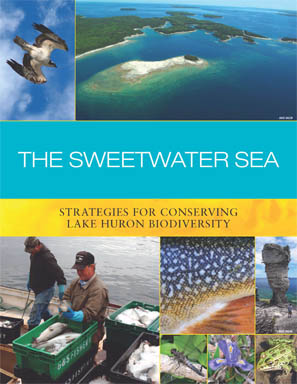Conserving biodiversity for valued Lake Huron ecosystems
Illustrating the importance of biodiversity, a bi-national planning initiative and report explores status and issues, opportunities and strategies for conserving Lake Huron biodiversity.
Our Great Lakes and coastal natural resources are ecologically rich and provide us many social and economic values, ranging from scenic views and wildlife watching to clean water and fishing. These values depend upon environmental health and properly functioning ecosystems. They also depend upon a broad diversity or biodiversity of habitats and species (plants and animals) living within these Great Lakes habitats, essential to the ecological health and function of these invaluable ecosystems. To narrow our focus and further illustrate the importance, challenges, and opportunities of conserving biodiversity in the Great Lakes, we turn to a Lake Huron-focused report, “The Sweetwater Sea: An International Biodiversity Conservation Strategy for Lake Huron.” This Lake Huron watershed-focused report, published in 2010 and relevant yet today, explores conservation of biodiversity features specific to the health of Lake Huron, and reflects the direction of biodiversity conservation efforts toward Lake Huron ecosystems today. 
This report was the product of a two-year, bi-national collaborative planning processes involving more than 100 agencies and organizations (nearly 400 individuals involved) from around the Lake Huron watershed basin. Gathering existing research and scientific information, convening conservation experts and stakeholders, identifying key biodiversity features (and threats to biodiversity), and creating a vision and portfolio of conservation strategies for Lake Huron’s future were part of this detailed planning process. As outlined in the report summary, specific project goals aimed to:
- Assemble available biodiversity information,
- Define international vision and goals for biodiversity conservation for Lake Huron,
- Develop shared strategies for protecting important areas and abating threats,
- Promote international coordination of biodiversity conservation efforts,
- Provide a framework for measuring, managing and reporting biodiversity conservation efforts,
- Support, connect and advance previous and ongoing conservation efforts across the basin
This report compiles a wealth of scientific research and input from conservation experts, including mapped visualizations developed using Global Information System (GIS) database information and technology, in assessing and outlining biodiversity conservation strategies for Lake Huron; including:
- Identifies, explores biodiversity features: Specific habitat communities or indicator species, were identified with the purpose of representing the whole of Lake Huron’s diversity of ecosystems. Habitat communities included open and near-shore waters, coastal wetlands and islands, along with the coastal terrestrial ecosystems (and key native species within these habitats); with specific attention paid toward native migratory fish such as lake sturgeon and airborne species such as birds, bats, and butterflies.
- Assesses current status and conditions of these features: Drawing upon current research and expertise of Lake Huron scientists, indicators and measures were established by which to describe current condition (and by which to measure future changes in condition).
- Identifies and prioritizes threats to biodiversity: Primary threats assessed include non-native invasive species, both aquatic and terrestrial. Also habitat loss or degradation resulting from shoreline alteration and housing/urban development, dams and barriers within watersheds, non-point pollution from sources, and climate change factors.
- Outlines Biodiversity Conservation Strategies: GIS data was used to help map and rank important areas for biodiversity protection or restoration, and the report details specific strategies intended to respond to and address specific threats. Highlighted examples strategies outlined include land and water protection/management (e.g. implementing land use best management practices), specific species management aimed at restoring native species, education and awareness, laws and policies, and capacity building efforts (e.g. expanding research, resources, and coordination among partners).
This lake-wide Lake Huron effort was co-led by Michigan State University Extension Michigan Sea Grant and Michigan Natural Features Inventory working in partnership with The Nature Conservancy, Michigan Department of Natural Resources, Michigan Department of Environmental Quality, Environment Canada, Ontario Ministry of Natural Resources, and The Nature Conservancy of Canada. This project was coordinated with the Lake Huron Bi-national Partnership, and supported by funding provided by the Great Lakes National Program Office of the U.S. Environmental Protection Agency, Environment Canada, the Fred A. and Barbara M. Erb Family Foundation, the Chrysler Foundation, and the Mott Foundation.
Want to learn more about biodiversity on Lake Huron? Visit Michigan Sea Grant online to explore more about biodiversity in the Great Lakes and access “The Sweetwater Sea” executive summary and full technical report detailing this Lake Huron conservation planning initiative.



 Print
Print Email
Email

